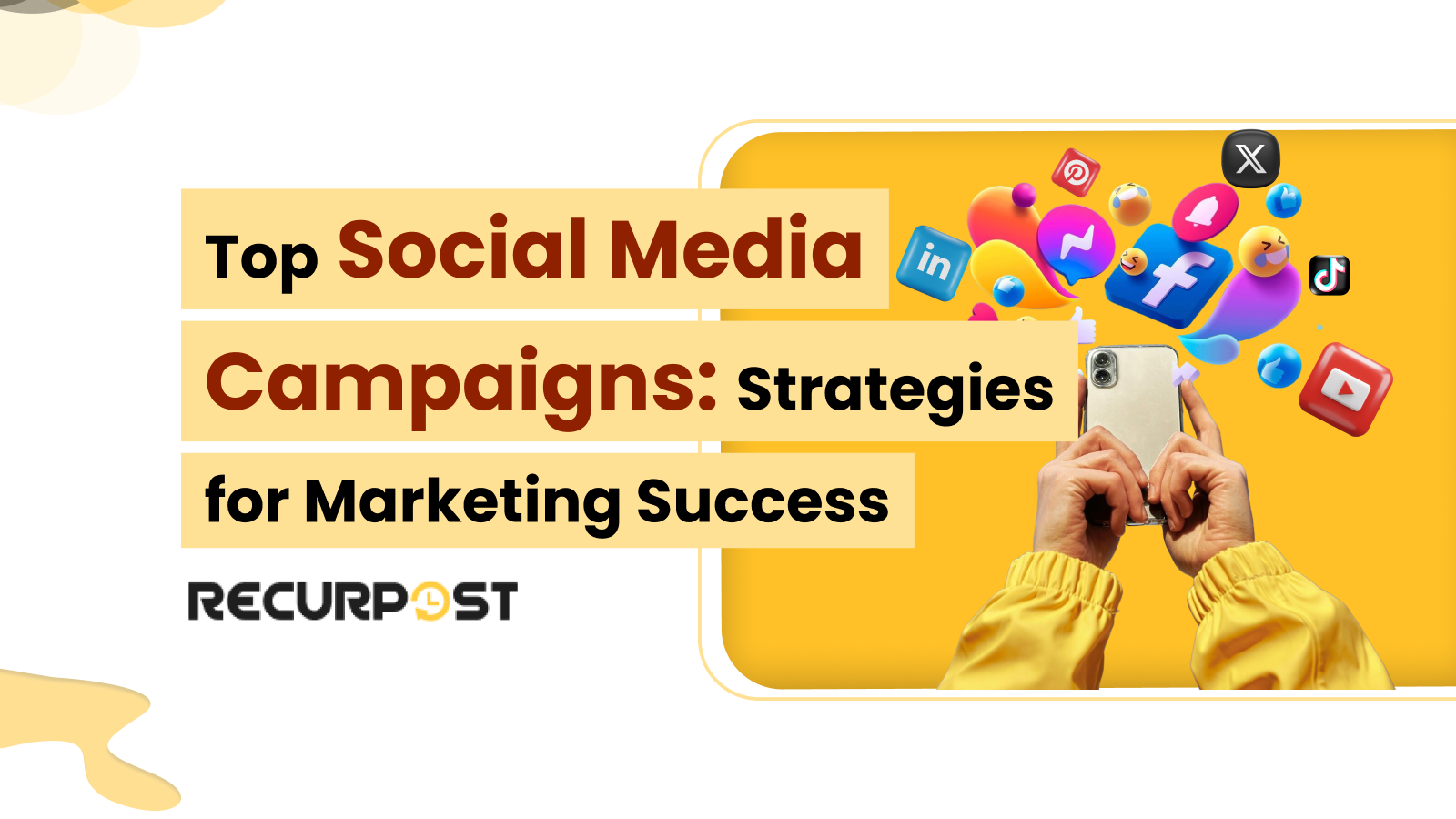Social media marketing campaigns vary in effectiveness across brands. Learning from successful social media campaigns that delivered measurable results offers actionable insights. This post looks at seven successful social media campaigns, reviewing the tactics and results that made them successful.
Top Successful Social Media Campaigns
1. Nike’s “Just Do It” Campaign

Overview: Nike’s “Just Do It” social media campaign, launched in 1988, ranks among the most successful social media campaigns in history. The campaign functioned as a call to action that resonated with both athletes and non-athletes, motivating people to push their limits and engage with Nike’s messaging.
Subtle Details and Strategies:
- Emotional Storytelling: The genius of “Just Do It” lies in its simplicity and emotional connection. Nike shared stories of athletes overcoming challenges, both in sports and in life. This narrative resonated with the audience, inspiring them to view Nike as a partner in their personal and athletic journeys.
- Inclusivity: The campaign didn’t just focus on elite athletes; it showcased stories from everyday people, making it relatable and broadening Nike’s appeal. This expanded the campaign’s reach to include anyone looking to improve their lives through physical activity.
- Evolution Over Time: Nike has kept the “Just Do It” message relevant by adapting it to current cultural contexts. For instance, the 2018 version featuring Colin Kaepernick took a stand on social justice, sparking global conversations and connecting Nike with a new generation of socially conscious consumers.
Results Achieved: Nike’s “Just Do It” social media campaign boosted company sales from $877 million in 1988 to over $9 billion a decade later. The campaign solidified Nike’s position as a brand representing values beyond athletic gear.
Key Takeaways: Consistent messaging and emotional storytelling create long-lasting audience connections. Nike’s evolution of the campaign kept the “Just Do It” message relevant across generations, establishing it among the most successful social media campaigns.
2. Starbucks’ “Red Cup Contest”
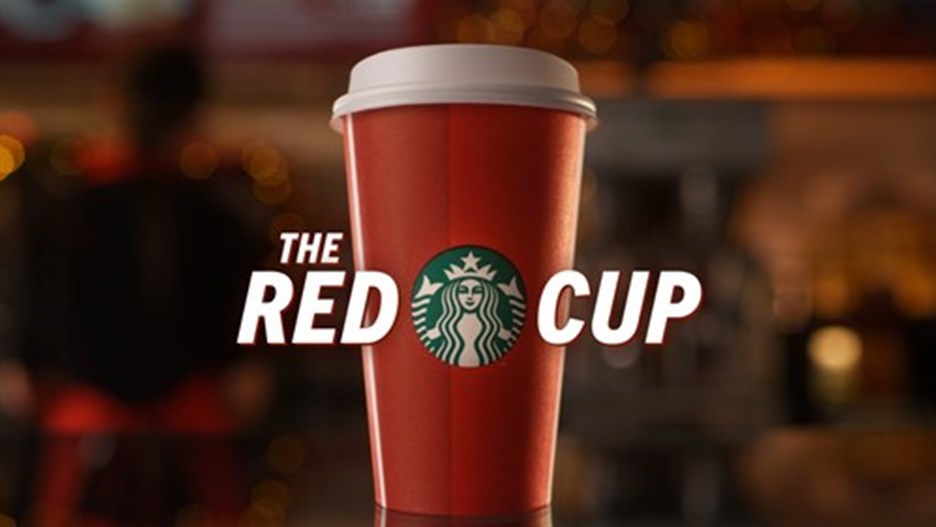
Campaign Overview: Starbucks’ red cups have become an iconic symbol of the holiday season. In 2015, Starbucks took advantage of this association by launching the “Red Cup Contest,” encouraging customers to share their decorated red cups on social media.
Subtle Details and Strategies:
- Leveraging Tradition: Starbucks knew that its red cups were already a beloved tradition for many customers. By launching a contest around these cups, they strengthened the existing emotional connection, increasing engagement and making it easier for the campaign to gain traction.
- User-Generated Content: The contest relied on user-generated content, which not only boosted engagement but also provided Starbucks with a wealth of content to share across its own social channels. This approach reduced content creation costs while amplifying reach through customer participation.
- Hashtag Strategy: Starbucks used a specific hashtag for the contest, making it easy to track entries and measure engagement. The hashtag also helped build a sense of community among participants, as they could easily interact with other entries. To craft a winning hashtag strategy like Starbucks, check out our guide on popular hashtags to boost your campaign’s reach and engagement.
Results Achieved: The “Red Cup Contest” generated over 40,000 entries within the first two days, with more than 200,000 entries overall, making it one of the most successful social media campaigns. This not only increased engagement but also reinforced the emotional bond between Starbucks and the holiday season.
Key Takeaways: Tapping into existing traditions or emotional connections can boost engagement. User-generated content not only drives participation but also provides valuable content for the brand to share, amplifying reach and credibility, making it one of the more successful social media campaigns.
3. ALS Ice Bucket Challenge
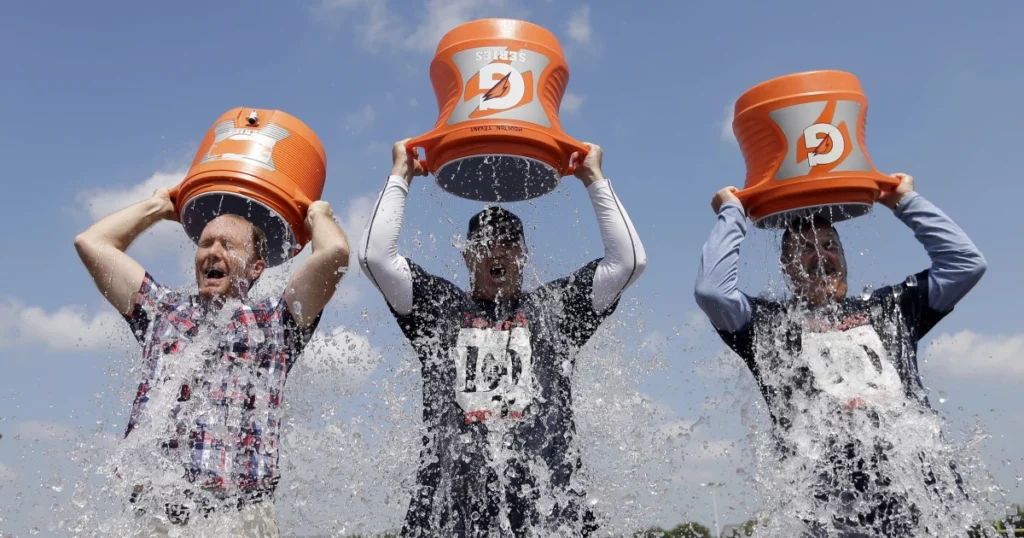
Overview: The ALS Ice Bucket Challenge in 2014 became a global phenomenon, raising awareness and funds for ALS research. Participants would dump a bucket of ice water over their heads, share the video on social media, and challenge others to join in.
Subtle Details and Strategies:
- Viral Element: The challenge’s viral nature was embedded in its design. By challenging others to participate, each person who took part effectively recruited new participants, creating a snowball effect that quickly expanded the campaign’s reach.
- Simplicity and Accessibility: The Ice Bucket Challenge was simple to join; anyone with a smartphone and a bucket of water could participate in this campaign challenge. This simplicity made it accessible to a wide audience, removing barriers to participation.
- Celebrity Involvement: The campaign gained significant momentum when celebrities and public figures began joining in and challenging others. Their participation brought widespread media attention and further amplified the campaign’s reach.
Results Achieved: The Ice Bucket Challenge raised over $115 million for ALS research in just a few months. It also boosted awareness of the disease, leading to ongoing donations and support for ALS organizations.
Key Takeaways: Adding a viral element to your campaign can greatly expand its reach. Simplicity and accessibility encourage widespread participation, and involving influencers or celebrities can help amplify your message, making it one of the most successful social media campaigns.
4. Airbnb’s #WeAccept Campaign
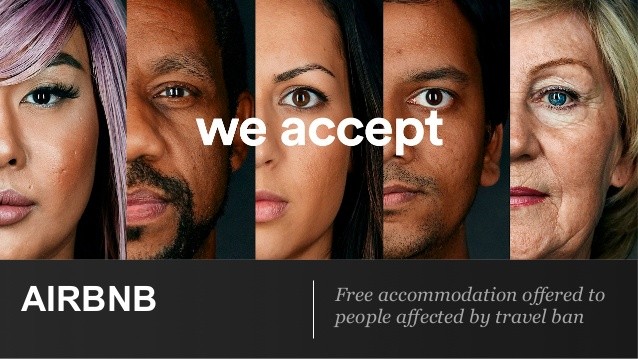
Overview: Airbnb’s #WeAccept social media campaign was launched during the 2017 Super Bowl, addressing the growing discourse around diversity and inclusion. The campaign highlighted Airbnb’s commitment to providing a platform for people of all backgrounds, emphasizing the value of acceptance
Subtle Details and Strategies:
- Social Consciousness: The campaign was timed to coincide with the travel ban in the U.S., making its message of acceptance particularly poignant. By aligning the campaign with a current social issue, Airbnb was able to connect deeply with both existing users and potential new customers who valued diversity.
- Visual Impact: The campaign featured a powerful video showing faces of diverse individuals, paired with a simple, strong message: “We believe no matter who you are, where you’re from, who you love, or who you worship, we all belong. The world is more beautiful the more you accept.” The visual storytelling was straightforward yet profoundly impactful, fostering an emotional connection with the audience.
- Hashtag Engagement: Airbnb encouraged people to share their own stories of acceptance using the hashtag #WeAccept. This not only boosted engagement but also allowed users to feel like they were part of a larger, positive movement. The hashtag made it easy for people to find and connect with the campaign, amplifying its reach.
Results Achieved: The #WeAccept campaign led to a 10% increase in bookings, particularly in regions directly impacted by the travel ban. The campaign also significantly enhanced Airbnb’s brand reputation, positioning it as a company that stands for inclusivity and social good.
Key Takeaways: Aligning your brand with a social cause can create a powerful connection with your audience, especially when the cause resonates with current events. Visual storytelling, combined with a strong, inclusive message, can drive both emotional engagement and measurable business results, making it one of the most successful social media campaigns of its time.
5. Coca-Cola’s “Share a Coke” Campaign
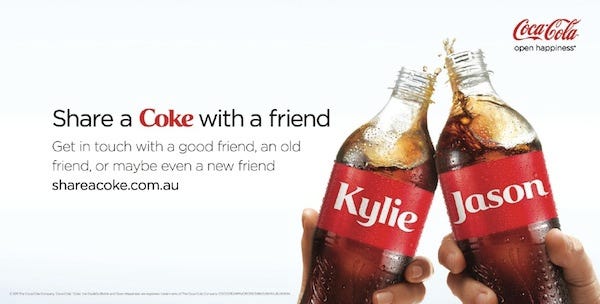
Overview: Coca-Cola’s “Share a Coke” social media campaign personalized its iconic bottles by replacing the Coke logo with popular names. This simple yet clever idea turned a product into a personal experience, motivating people to share a Coke with someone named on the bottle.
Subtle Details and Strategies:
- Personalization: The campaign capitalized on personalization. Coca-Cola created products that felt unique to each consumer by placing names on bottles. This personalization strengthened the emotional bond with customers when they saw their own or a loved one’s name on a Coke bottle, driving deeper brand engagement.
- Social Sharing: Coca-Cola encouraged customers to share photos of their personalized bottles on social media using the hashtag #ShareACoke. This user-generated content spurred significant engagement, allowing customers to share personal moments with friends and family, boosting brand loyalty.
- Integrated Marketing: The campaign was supported by an integrated marketing strategy that included TV commercials, in-store promotions, and social media. This multi-channel approach maximized the campaign’s impact, ensuring consistent messaging and wide reach across all platforms, driving continued consumer interest.
Results Achieved: The “Share a Coke” campaign resulted in a 2% increase in U.S. sales after a decade of declining revenue. It also sparked a global trend, with millions of personalized bottles being shared on social media, driving brand engagement to new heights.
Key Takeaways: Personalization can create a strong emotional connection with consumers, making them more likely to engage with and share your product. An integrated marketing approach that combines traditional and digital channels can amplify the impact of a campaign, ensuring consistent reach and messaging, solidifying its place among successful social media campaigns.
6. Dove’s “Real Beauty Sketches” Campaign

Overview: Dove’s “Real Beauty” social media campaign, launched in 2004, challenged traditional beauty standards by featuring women of all shapes, sizes, and ethnicities. The campaign promoted self-confidence and redefined beauty inclusively. In 2013, Dove launched “Real Beauty Sketches,” where a forensic artist drew women based on self-descriptions and stranger descriptions. The sketches revealed how women view themselves more harshly than others see them, making it one of the most unique social media campaigns.
Subtle Details and Strategies:
- Emotional Storytelling: The “Real Beauty Sketches” campaign was a masterclass in emotional storytelling. By showing women how they perceive themselves versus how others see them, Dove tapped into deep issues around self-esteem and body image. The campaign struck an emotional chord with viewers, prompting them to reflect on their own self-perceptions and connect with the brand’s message.
- Viral Video Content: Dove used video as the primary medium for this campaign, understanding that emotionally charged content is more likely to be shared. The videos were professionally produced, with a focus on authenticity and emotional impact, making them highly shareable across social media platforms and increasing campaign reach.
- Broad Social Sharing: The campaign encouraged women to share their reactions to the video on social media, further amplifying its reach. Dove also leveraged the power of influencers and media coverage to spread the message, turning the campaign into a global phenomenon and extending its reach.
Results Achieved: “Real Beauty Sketches” became one of the most shared video ads of all time, amassing over 114 million views in just one month. The campaign significantly enhanced Dove’s brand image, reinforcing its commitment to promoting real beauty, self-confidence, and inclusivity.
Key Takeaways: Emotional storytelling, especially when it taps into universal human experiences, can create powerful, viral content. Videos are particularly effective for conveying complex emotions and messages, making them a key tool for successful social media campaigns.
7. Always’ #LikeAGirl Campaign
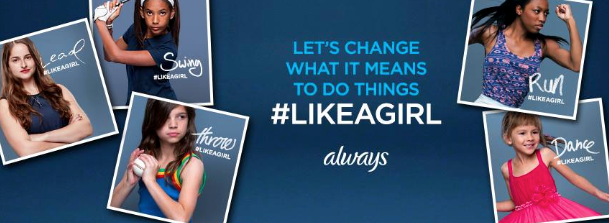
Overview: Always, a brand known for feminine hygiene products, launched the #LikeAGirl social media campaign in 2014 with the goal of redefining what it means to do something “like a girl.” The campaign sought to challenge and change the negative connotations associated with the phrase and empower young girls to embrace their identity with pride.
Subtle Details and Strategies:
- Empowering Messaging: The core of the #LikeAGirl campaign was its empowering message. Always focused on changing the narrative around what it means to be a girl, using real stories and emotions to connect deeply with its audience. The campaign was not just about promoting products but about making a positive social impact and fostering a deeper emotional connection with viewers.
- Viral Video Content: The campaign’s centerpiece was a video that asked people to demonstrate what it means to run, throw, or fight “like a girl.” The video highlighted the stark difference in perception between younger girls and older participants, revealing how societal expectations can undermine confidence. This powerful video content struck an emotional chord with viewers, making it highly shareable across social media platforms, amplifying the campaign’s reach.
- Hashtag Campaign: The hashtag #LikeAGirl encouraged social media users to share their own stories of empowerment and pride. This user-generated content amplified the campaign’s reach, creating a global conversation around the phrase and turning a once-insulting term into a statement of strength, resonating with audiences worldwide.
Results Achieved: The #LikeAGirl video quickly went viral, garnering over 85 million views on YouTube and becoming one of the most shared ads in 2014. The campaign received widespread media coverage, significantly boosting Always’s brand visibility and positioning it as a champion of women’s empowerment. This social media campaign also won numerous awards, including a Grand Prix at the Cannes Lions International Festival of Creativity, further enhancing the brand’s reputation.
Key Takeaways: Social media campaigns that challenge societal norms and offer a positive, empowering message can resonate deeply with audiences and create lasting change. Always’ #LikeAGirl social media campaign demonstrates how aligning your brand with a meaningful cause can drive massive engagement and redefine brand perception, showcasing one of the major benefits of social media marketing in the sphere of social impact.
What Makes a Social Media Marketing Campaign Successful?
A successful social media campaign achieves specific business objectives through strategic actions. The most successful social media campaigns:
- Align with Business Goals: Actions serve business objectives like increasing brand awareness, driving sales, or expanding audience reach.
- Engage the Audience: Social media campaigns resonate emotionally, prompting audience engagement, sharing, and participation.
- Leverage the Right Platforms: Successful social media campaigns utilize platforms that best serve their goals and reach their target audience.
- Measure and Optimize: Performance tracking and data-based optimization ensure that social media campaigns stay on track toward their goals.
Here we have seen seven successful social media campaigns that exemplified these principles and delivered outstanding results.
Analyzing the Strategies of Successful Social Media Campaigns
Common strategies across successful social media campaigns include:
- Emotional Storytelling: Social media campaigns tap emotional currents through Nike’s motivational narratives or Dove’s self-perception exploration. Emotional content resonates deeply with audiences and generates more shares, boosting campaign reach.
- Audience Engagement: User-generated content, challenges, and hashtags involve audiences in brand stories. This engagement strengthens the community around brands and drives greater social media participation.
- Timely and Relevant Content: Airbnb’s #WeAccept and the ALS Ice Bucket Challenge succeeded by addressing current issues relevant to audiences, making these social media campaigns resonate deeply with a wide range of people.
- Consistent Messaging: Dove and other brands maintain consistent messages across platforms, reinforcing core values and creating strong, recognizable brand identities that attract and retain loyal followers.
How to Plan a Social Media Campaign
Examining the case studies, let’s start with the essentials and dynamics of planning social media campaigns. A solid plan ensures that every action is intentional and aligns with your social media campaign’s objectives.
1. Define Your Campaign’s Objectives
Your social media campaign needs a clear direction, beginning with setting specific, measurable objectives. These objectives could range from increasing brand awareness to driving website traffic, generating leads, or even growing your social media presence. The more precise your goals, the easier it will be to track social media campaigns and measure success.
For instance, your campaign might aim to boost website traffic by 20% over three months. This can be broken down into smaller goals, such as a 15% increase in social media engagement and a 10% rise in referral traffic. Such detailed planning ensures that every piece of content serves a purpose in creating a successful social media campaign proposal.
2. Know Your Audience
Understanding your target audience is crucial for creating content that resonates. Develop audience personas, detailed profiles of your ideal customers, including demographics, interests, challenges, and behaviors. These personas help tailor your content to directly address your client goals, audience needs, and desires, which is key to running successful social media campaigns.
For example, if you’re targeting tech-savvy millennials, your content should be visually appealing and shareable, potentially using platforms like Instagram and TikTok that cater to this demographic. Knowing your audience helps in selecting the right tone, style, and content types to engage them effectively in your social media campaigns
3. Choose the Right Platforms
The social media platforms you choose to launch your campaign or social media campaign advertisements on should be where your target audience spends most of their time and where your paid advertising budget will generate the highest return on investment. Different platforms serve different purposes: Instagram and Pinterest are great for visual content, LinkedIn is ideal for B2B marketing, and Twitter excels at real-time engagement.
Each platform has its own best practices. For example, Instagram thrives on high-quality images and videos with concise, engaging captions, making it ideal for an Instagram marketing campaign, while LinkedIn posts can be more text-heavy, focusing on thought leadership and industry insights. Choosing the right platform is about understanding its strengths and where your audience is most active, crucial for any successful social media campaign.
4. Content Planning and Strategy
Content planning and social media strategies involve deciding not just what to post but also when to post it. A social media content calendar is essential for organizing and scheduling posts to ensure consistent engagement, especially when implementing a campaign approach to social media posting that requires coordinated messaging across multiple touchpoints. Consistency builds momentum and keeps your audience engaged throughout the campaign, a hallmark of successful social media campaigns.
Diversify your Social media campaigns’ content types, videos, infographics, user-generated content, and blog posts can all play a role in your campaign. Referring to the best social media blogs can inspire fresh ideas and innovative approaches for using these content types effectively. For instance, you might use short teaser videos to generate interest, followed by detailed blog posts or infographics providing in-depth information.
Consider the tone and messaging of your content. Is it aligned with your brand values? Does it resonate with your audience’s pain points? Strategic content planning ensures your message is clear and compelling, contributing to a successful social media campaign and fostering strong audience relationships.
Related: 13 Christmas Marketing Campaign Ideas to Boost Christmas Sales
5. Social Media Campaigns Budget and Resources
Allocating your social media budget effectively is key to maximizing your campaign’s impact. This includes spending on content creation, paid ads, and tools for analytics and automation. Even with a limited budget, you can achieve significant results by focusing on high-impact activities.
Typical Campaign Costs by Scale:
- Small-scale campaigns ($1,000-$5,000): Suitable for local businesses or targeted promotions, covering basic content creation, limited paid promotion, and essential tools for social media management.
- Medium-scale campaigns ($5,000-$25,000): Appropriate for regional businesses or product launches, including professional content creation, moderate ad spend, and comprehensive analytics tools for monitoring performance.
- Large-scale campaigns ($25,000-$100,000+): Designed for national or international brands, featuring premium content production, extensive ad budgets, influencer partnerships, and advanced analytics for measuring success.
Calculating Social Media Campaign ROI:
To determine if your social media campaign delivers positive returns, use this formula:
(Value Generated – Campaign Cost) ÷ Campaign Cost × 100 = ROI %
For social media campaigns, value generation may include:
- Direct revenue from campaign-attributed sales
- Lead value (number of leads × average lead conversion rate × average customer value)
- Brand awareness value (estimated using reach, engagement, and industry benchmarks)
- Customer retention value (increased lifetime value of existing customers)
For example, if your $5,000 campaign generates $15,000 in attributable sales, your ROI calculation would be:
($15,000 – $5,000) ÷ $5,000 × 100 = 200% ROI
For example, instead of spreading your budget thin across multiple platforms, invest heavily in one platform where you’ve seen the most engagement. Alternatively, allocate more resources to high-quality content creation, knowing that visually appealing, well-crafted content is more likely to drive engagement and boost audience participation.
If you’re managing a small business with a limited budget, consider leveraging cost-effective strategies by using tools like Canva for graphic design or free trials of social media management platforms like RecurPost to streamline your efforts. Efficient resource allocation is crucial to executing successful social media campaigns and increasing overall ROI.
6. Social Media Metrics and KPIs
Determining your key performance indicators (KPIs) is critical for measuring your social media campaign’s success. These might include metrics like reach, engagement, conversion rates, or return on investment (ROI). Setting these social media metrics upfront allows you to track progress and make data-driven adjustments as needed.
Related Post: Learn more about Fresh Social Media Marketing Ideas
For example, if your goal is to increase engagement, your KPIs might include the number of likes, shares, and comments on your posts. If your campaign’s objective is to drive sales, conversion rates, and cost per acquisition will be more relevant. Using social media analytics tools like RecurPost will help you monitor these metrics and refine your strategy in real-time, ensuring a successful social media campaign and maximizing ROI.
For financial professionals looking to enhance their social media presence and reach target audiences, the best digital marketing agencies worldwide can provide invaluable strategies. Check out our blog on social media for financial services.
Industry-Specific Social Media Campaign Examples
While the major brand social media campaigns we’ve examined provide valuable insights, different industries face unique challenges and opportunities when creating social media campaigns. Here’s how various sectors have implemented successful social media campaigns and best practices:
Retail, E-commerce, and Consumer Brands
Retail brands like ASOS have found success with user-generated content campaigns, encouraging customers to share photos wearing their products with specific hashtags. These campaigns generate authentic content while building community among shoppers. Fashion retailer H&M’s sustainability campaign #HMConscious raised awareness about environmentally friendly practices while promoting their eco-friendly clothing line. Such campaigns drive social media engagement and brand loyalty.
B2B, Professional Services, and Thought Leadership
LinkedIn-focused campaigns work particularly well for B2B companies. IBM’s #IBMWhatMakesGreat campaign featured thought leadership content addressing business challenges, positioning the company as an industry authority while generating leads. HubSpot’s educational content campaigns provide valuable resources to potential customers, establishing trust before the sales process begins and enhancing the brand’s reputation..
Food, Beverage, and Consumer Goods
Beyond Coca-Cola’s “Share a Coke,” restaurants and food brands have found success with visual content campaigns showcasing their products. Chipotle’s “Behind the Foil” transparency campaign used social media to highlight its food preparation processes, addressing consumer concerns about food quality and safety while building trust. Such social media campaigns drive brand loyalty and social media engagement.
Travel, Tourism, and Hospitality
Travel companies excel with aspirational content and user-generated campaigns. Marriott Hotels’ “Travel Brilliantly” campaign solicited customer ideas for improving the travel experience, generating engagement while gathering valuable customer insights. Tourism Australia’s #SeeAustralia campaign curates stunning user-generated content, inspiring travel while showcasing authentic experiences. These campaigns increase engagement and build brand affinity.
Healthcare, Wellness, and Public Health
Healthcare organizations have created impactful awareness social media campaigns. The Cleveland Clinic’s #MoveThisMonth campaign encouraged physical activity through educational content and community challenges, while pharmaceutical company Pfizer’s #ScienceWillWin campaign during the pandemic built public trust through transparent information about vaccine development. Such social media campaigns foster community engagement and promote positive social impact.
Conclusion
These seven case studies illustrate that successful social media campaigns, much like the best online marketing campaigns, are built on strong strategies, emotional connections, and consistent messaging. Whether you’re a seasoned digital marketer or a small business owner just starting out, the lessons from these social media campaigns can guide you in crafting your own successful management services, social marketing ideas, and strategies.
Remember, social media marketing is about more than just being seen; it’s about understanding your business perfectly and creating meaningful interactions that resonate with your audience, building engagement, and driving tangible results.
By leveraging the insights from these successful digital and social media marketing campaigns, you can develop innovative social media campaign ideas that not only generate buzz but also achieve your specific business goals. So, get creative, plan strategically, and start building your next successful social media campaign today, ensuring strong brand engagement.
FAQs: Social Media Campaigns
1. How long should a social media campaign run?
The duration of a social media campaign depends on its objectives. Short-term social media campaigns (2-4 weeks) are ideal for promotions or product launches, while long-term social media campaigns (3-6 months) work better for brand awareness or engagement. Regular monitoring and adjustment are key to maintaining momentum and ensuring the effectiveness of the campaign.
2. What’s the best way to measure the success of my campaign?
The success of your social media campaigns can be measured through various KPIs depending on your goals. Common metrics include engagement rates (likes, shares, comments), reach, impressions, conversion rates, and ROI. Tools like Google Analytics, Facebook Insights, and Hootsuite can help you track these metrics and gain valuable insights into your campaign’s performance.
3. How can I create a social media campaign with a limited budget?
Focus on organic growth strategies like user-generated content, influencer partnerships, and leveraging free tools like Canva for content creation. Paid ads can be highly targeted to maximize ROI, even with a small budget. Prioritize platforms that offer the best engagement for your audience and use social media analytics to continuously optimize your efforts.
4. What kind of content works best for social media campaigns?
Content types that perform well on social media include videos, user-generated content, infographics, and interactive content like polls or quizzes. The most effective content is often visually engaging, emotionally resonant, and relevant to your audience’s interests. Diversify your content to maintain engagement and cater to different preferences.
5. How often should I post during a campaign?
Posting frequency depends on the platform and your audience’s behavior. For platforms like Twitter, multiple posts per day can be effective, while on Instagram or Facebook, 1-2 posts per day might be sufficient. Consistency is key. Use a content calendar to maintain regular posting and ensure your audience remains engaged throughout the campaign
6. How do I choose the right influencers for my campaign?
Choose influencers who align with your brand values and have an audience that matches your target demographic. Micro-influencers (with 10,000-100,000 followers) can be more effective for engagement than celebrities, as their followers often trust them more. Look for influencers who genuinely believe in your product or service, as authenticity is key to successful influencer partnerships.
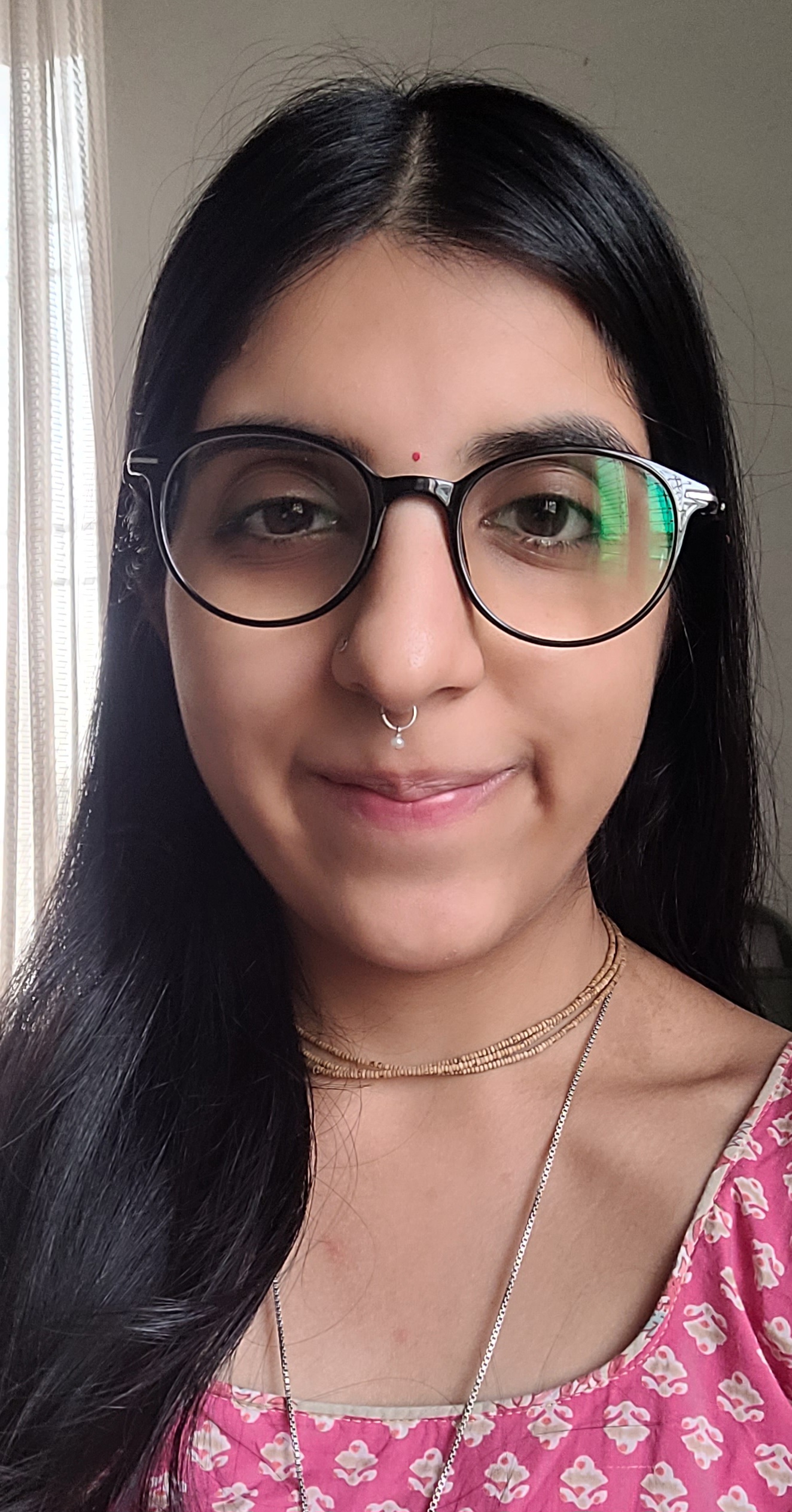
Vrinda Jagga is a dedicated content writer with over 2 years of experience in the field. She excels in creating engaging and informative content that resonates with diverse audiences. Vrinda’s expertise spans various industries, and she has a knack for crafting narratives that captivate readers.

